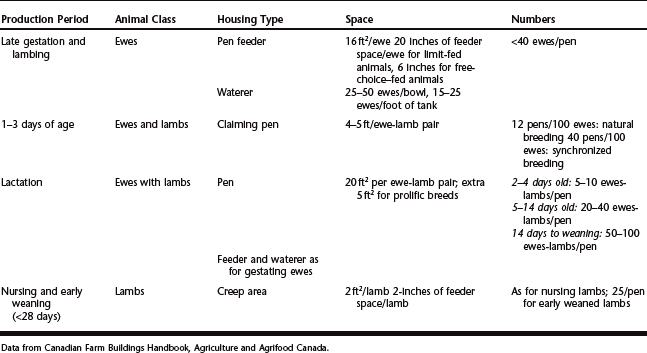CHAPTER 91 Lambing Management and Neonatal Care
PRELAMBING MANAGEMENT OF PREGNANT EWES
One Month before First Expected Lambing Date
Two Weeks before First Expected Lambing Date
The lambing area is prepared as follows:
Lambing and lamb processing equipment and medications should be available (Box 91-1).
Box 91-1 Lambing Equipment and Supplies Recommended for Sheep Producers
Lambing Equipment
Clippers or hand shears for crutching ewes
Prolapse retainers and soft rope
Chlorhexidine scrub for cleaning perineum
Two clean buckets: one for warm water to wash, one for cold water to revive lambs
Sterile lubricant (e.g., K-Y jelly)
Plastic disposable rectal sleeves
Lamb Feeding Equipment
Tube feeding kit with rubber tube and 60-ml syringe or 250-ml squeeze bottle
Source of frozen colostrum (bovine, caprine, or ovine)
Lamb milk replacer with nipples and bottles
Lamb Processing Equipment
2.5% iodine for painting umbilical cord stump
Sterile syringes: 1-ml, 3-ml, and 60-ml
Sterile needles: 22-gauge and 20-gauge, 1-inch
Empty Javex bottle with lid for sharps disposal
Digital thermometer with a readout to 36° C
Equipment for tail docking and castration (rings, hot-docker, Burdizzo emasculators)
Medications*
Propylene glycol and drench gun or drench bottle
Injectable vitamin E and selenium product labeled for newborn lambs
Multivalent clostridial vaccine
Contagious ecthyma vaccine (optional)
Calcium borogluconate for subcutaneous administration
50% dextrose to be diluted for treatment of hypoglycemic lambs
Oral electrolyte (registered for calf use)
Antibiotics: penicillin and long-acting oxytetracycline
INDUCTION OF PARTURITION
Induction of lambing can be done if the breeding date is known within an accuracy of 3 days—for example, if breeding was synchronized using hormones and only one breeding opportunity occurred. Ewes will respond to an injection of dexamethasone (16 mg given intramuscularly [IM]) or betamethasone (10 to 12 mg IM) after day 137, but it is preferred to wait until day 142 to ensure good fetal viability. Commonly, producers may wait for the first few lambs to be born and then induce the rest of the pregnant ewes. Lambing generally occurs between 36 and 60 hours after induction. Induction is not associated with an increased risk of retained fetal membranes. In instances of vaginal prolapse or pregnancy toxemia, it may be advisable to induce as early as day 137, with the goal of saving the ewe.
MANAGEMENT OF DYSTOCIA
Correction of Dystocia
The practitioner should ensure that the proper tools and protection are available and that the gloves are well lubricated (see Box 91-1). The uterine wall is friable, so only gentle manipulation is advised. A tear in the uterus leads to peritonitis, which is not well tolerated in sheep.
With poor cervical dilation, the practitioner attempts gentle manual dilation, keeping the hand and arm well lubricated. If after 10 minutes no progress is observed, the problem may be true ringwomb. In this condition, the cervix does not undergo the normal parturient softening. The cervical softening process starts with the prepartal drop in progesterone. This triggers an infiltration of leukocytes, which causes collagen degradation and hence softening. The cause for failure of the cervical softening process is not known. Some success at treatment has been reported with application of an estrogen product or prostaglandin E2α to the cervical area, or with injection of such agents, and followed in a few hours by oxytocin. The alternative is cesarean section.
Cesarean Section
Anesthesia for performing a cesarean section can be obtained using one of the following methods.




